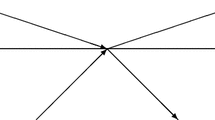Abstract
In a recently proposed quantum measurement theory the definiteness of quantum measurements is achieved by means of “special” states. The recovery of the usual quantum probabilities is related to the relative abundance of particular classes of “special” states. In the present article we consider two-state discrimination, and model the apparatus modes that could provide the “special” states. We find that there are structural features which, if generally present in apparatus, will provide universal recovery of standard probabilities. These structural features relate to the distribution of certain Hamiltonian matrix elements or interaction times. In particular, those quantities must be asymptotically (x → ∞) distributed according to the Cauchy law, Ca(x)=a/π(x2+a2).
Similar content being viewed by others
References
L. S. Schulman,J. Stat. Phys. 42, 689 (1986);Phys. Lett. A 102, 396 (1984);Phys. Lett. A 130, 194 (1988);Ann. Phys. (N.Y.) 183, 320 (1988);Found. Phys. Lett. 2, 515 (1989); inPath Integrals from meV to MeV, V. Sa-Yakanitet al., eds. (World Scientific, Singapore, 1989), p. 35.
B. Gaveau and L. S. Schulman,J. Stat. Phys. 58, 1209 (1990).
L. S. Schulman, C. R. Doering, and B. Gaveau, “Quantum decay in multi-level systems,”J. Phys. A 24, 2053 (1991).
L. S. Schulman, “Definite quantum measurements,”Ann. Phys. (N.Y.), to appear (1991).
M. Born, “Zur Quantenmechanik der Stossvorgänge,”Z. Phys. 37, 863 (1926); translation printed in J. A. Wheeler and W. H. Zurek,Quantum Theory and Measurement (Princeton University Press, Princeton, 1983).
M. F. Shlesinger,Physica D 38, 304 (1989); B. D. Hughes, E. W. Montroll, and M. F. Shlesinger,J. Stat. Phys. 28, 111 (1982); E. W. Montroll and B. J. West, inFluctuation Phenomena, E. W. Montroll and J. L. Lebowitz, eds., 2nd edn. (North-Holland, Amsterdam, 1987).
W. Feller,An Introduction to Probability Theory and Its Applications, Vol. II (Wiley, New York, 1971).
E. P. Wigner,Z. Phys. 131, 101 (1952); H. Araki and M. Yanase,Phys. Rev. 120, 622 (1960); M. Yanase,Phys. Rev. 123, 666 (1961).
T. L. Bell, U. Frisch, and H. Frisch,Phys. Rev. A 17, 1049 (1978).
J. E. Avron, G. Roepstorff, and L. S. Schulman, “Ground state degeneracy and ferromagnetism in a spin glass,”J. Stat. Phys. 26, 25 (1981).
H. Scher, M. F. Shlesinger, and J. T. Bendler, “Time-scale invariance in transport and relaxation,”Phys. Today 44(1), 26 (1991).
Author information
Authors and Affiliations
Rights and permissions
About this article
Cite this article
Schulman, L.S. “Special” states in quantum measurement apparatus: Structural requirements for the recovery of standard probabilities. Found Phys 21, 931–945 (1991). https://doi.org/10.1007/BF00733216
Received:
Revised:
Issue Date:
DOI: https://doi.org/10.1007/BF00733216




